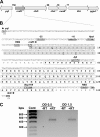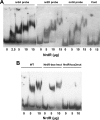NrdR controls differential expression of the Escherichia coli ribonucleotide reductase genes
- PMID: 17496099
- PMCID: PMC1951866
- DOI: 10.1128/JB.00440-07
NrdR controls differential expression of the Escherichia coli ribonucleotide reductase genes
Abstract
Escherichia coli possesses class Ia, class Ib, and class III ribonucleotide reductases (RNR). Under standard laboratory conditions, the aerobic class Ia nrdAB RNR genes are well expressed, whereas the aerobic class Ib nrdEF RNR genes are poorly expressed. The class III RNR is normally expressed under microaerophilic and anaerobic conditions. In this paper, we show that the E. coli YbaD protein differentially regulates the expression of the three sets of genes. YbaD is a homolog of the Streptomyces NrdR protein. It is not essential for growth and has been renamed NrdR. Previously, Streptomyces NrdR was shown to transcriptionally regulate RNR genes by binding to specific 16-bp sequence motifs, NrdR boxes, located in the regulatory regions of its RNR operons. All three E. coli RNR operons contain two such NrdR box motifs positioned in their regulatory regions. The NrdR boxes are located near to or overlap with the promoter elements. DNA binding experiments showed that NrdR binds to each of the upstream regulatory regions. We constructed deletions in nrdR (ybaD) and showed that they caused high-level induction of transcription of the class Ib RNR genes but had a much smaller effect on induction of transcription of the class Ia and class III RNR genes. We propose a model for differential regulation of the RNR genes based on binding of NrdR to the regulatory regions. The model assumes that differences in the positions of the NrdR binding sites, and in the sequences of the motifs themselves, determine the extent to which NrdR represses the transcription of each RNR operon.
Figures




Similar articles
-
The Streptomyces NrdR transcriptional regulator is a Zn ribbon/ATP cone protein that binds to the promoter regions of class Ia and class II ribonucleotide reductase operons.J Bacteriol. 2006 Nov;188(21):7635-44. doi: 10.1128/JB.00903-06. Epub 2006 Sep 1. J Bacteriol. 2006. PMID: 16950922 Free PMC article.
-
Alternative oxygen-dependent and oxygen-independent ribonucleotide reductases in Streptomyces: cross-regulation and physiological role in response to oxygen limitation.Mol Microbiol. 2004 Nov;54(4):1022-35. doi: 10.1111/j.1365-2958.2004.04325.x. Mol Microbiol. 2004. PMID: 15522084
-
Analysis of transcription of the Staphylococcus aureus aerobic class Ib and anaerobic class III ribonucleotide reductase genes in response to oxygen.J Bacteriol. 2001 Dec;183(24):7260-72. doi: 10.1128/JB.183.24.7260-7272.2001. J Bacteriol. 2001. PMID: 11717286 Free PMC article.
-
Deoxyribonucleotide synthesis in anaerobic microorganisms: the class III ribonucleotide reductase.Prog Nucleic Acid Res Mol Biol. 2002;72:95-127. doi: 10.1016/s0079-6603(02)72068-0. Prog Nucleic Acid Res Mol Biol. 2002. PMID: 12206460 Review.
-
Starting a new chapter on class Ia ribonucleotide reductases.Curr Opin Struct Biol. 2022 Dec;77:102489. doi: 10.1016/j.sbi.2022.102489. Epub 2022 Oct 19. Curr Opin Struct Biol. 2022. PMID: 36272229 Review.
Cited by
-
Function of the Pseudomonas aeruginosa NrdR Transcription Factor: Global Transcriptomic Analysis and Its Role on Ribonucleotide Reductase Gene Expression.PLoS One. 2015 Apr 24;10(4):e0123571. doi: 10.1371/journal.pone.0123571. eCollection 2015. PLoS One. 2015. PMID: 25909779 Free PMC article.
-
The tRNA thiolation pathway modulates the intracellular redox state in Escherichia coli.J Bacteriol. 2013 May;195(9):2039-49. doi: 10.1128/JB.02180-12. Epub 2013 Mar 1. J Bacteriol. 2013. PMID: 23457245 Free PMC article.
-
Ribonucleotide reductase NrdR as a novel regulator for motility and chemotaxis during adherent-invasive Escherichia coli infection.Infect Immun. 2015 Apr;83(4):1305-17. doi: 10.1128/IAI.02772-14. Epub 2015 Jan 20. Infect Immun. 2015. PMID: 25605769 Free PMC article.
-
Functional analysis of the Streptomyces coelicolor NrdR ATP-cone domain: role in nucleotide binding, oligomerization, and DNA interactions.J Bacteriol. 2009 Feb;191(4):1169-79. doi: 10.1128/JB.01145-08. Epub 2008 Dec 1. J Bacteriol. 2009. PMID: 19047342 Free PMC article.
-
Genome-wide screening with hydroxyurea reveals a link between nonessential ribosomal proteins and reactive oxygen species production.J Bacteriol. 2013 Mar;195(6):1226-35. doi: 10.1128/JB.02145-12. Epub 2013 Jan 4. J Bacteriol. 2013. PMID: 23292777 Free PMC article.
References
-
- Aravind, L., Y. I. Wolf, and E. V. Koonin. 2000. The ATP-cone: an evolutionarily mobile, ATP-binding regulatory domain. J. Mol. Microbiol. Biotechnol. 2:191-194. - PubMed
-
- Atkin, C. L., L. Thelander, P. Reichard, and G. Lang. 1973. Iron and free radical in ribonucleotide reductase. Exchange of iron and Mossbauer spectroscopy of the protein B2 subunit of the Escherichia coli enzyme. J. Biol. Chem. 248:7464-7472. - PubMed
-
- Blattner, F. R., G. Plunkett III, C. A. Bloch, N. T. Perna, V. Burland, M. Riley, J. Collado-Vides, J. D. Glasner, C. K. Rode, G. F. Mayhew, J. Gregor, N. W. Davis, H. A. Kirkpatrick, M. A. Goeden, D. J. Rose, B. Mau, and Y. Shao. 1997. The complete genome sequence of Escherichia coli K-12. Science 277:1453-1474. - PubMed
Publication types
MeSH terms
Substances
LinkOut - more resources
Full Text Sources
Molecular Biology Databases

